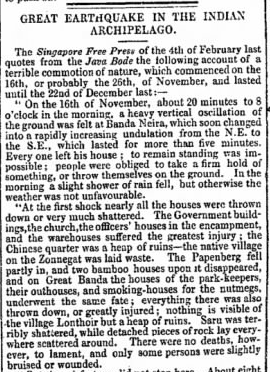On December 26, 2004, following a M9.2 earthquake that occurred off the western coast of Sumatra, Indonesia, a massive tsunami ripped through southeast Asia that ultimately resulted in the deaths of some 230,000 people in 14 countries. Indonesia was particularly affected by both physical damage and human casualties.
At Newspapers.com, we occasionally highlight ways our users find success in our archives. One team of geologists from Brigham Young University utilized information found in 19th-century newspapers to refine computer models of historic tsunamis in Indonesia in hopes of identifying future area of risks and to prevent future tsunamis from producing the massive loss of life seen in 2004.
Graduate student Claire Ashcraft frequently travels to Indonesia to work with government officials, gather geologic data, and to work with local communities to improve tsunami awareness and preparation.
Analysis of geologic evidence, such as the dating of tsunami sand deposits, help show which islands have experienced tsunamis. Historical records are also invaluable to the team. By isolating quantitative information in the written records, the data is applied to complex digital models to produce more accurate results. However, a lack of available records hampers this work; few accounts of Indonesian tsunamis survive, and most were written by Dutch colonists who arrived in the early 17th century.
Of particular interest to Ashcraft and her team are two tsunamis which took place in Central and Eastern Indonesia, the former in 1820 and the latter in 1852.
Recently, Ashcraft turned to Newspapers.com and was elated to find mentions of both events in historical papers. An 1821 clipping described the 1820 event (the news took months to arrive by ship), citing a Dutch newspaper article published in the Dutch East Indies in the city of Batavia (now Jakarta). With this lead, she was able to track down the original Dutch newspaper and find new quantitative information that had not yet seen.
Similarly, an 1853 clipping gave Ashcraft critical details. The article noted that a Dutch royal navy brig called “de Haai” experienced the tsunami and its captain made detailed observations throughout the day. After learning the name of this ship and its captain from Newspapers.com, Ashcraft took these names and began searching in Dutch East Indies nautical records for a connection. She quickly found a book which mentioned the brig in conjunction with key Dutch words she recognized, such as ‘aardbeving’ (earthquake) and ‘zeebeving’ (seaquake). After translating the record Ashcraft realized that it contained not only the full account of the navy brig, but a collection of seven other first-person records that provided a wealth of information previously unknown to the team.
Newspapers.com provided key details that allowed BYU researchers key data to improve computer models. The models will help the Indonesian government to identify areas affected by past tsunamis and prepare for future events.
Discover your success story by searching Newspapers.com today!




I want to trace a story in New Albany, In diana in 1858. Can you help? marshall.myers@eku.edu
can you give an idea of the story to search for a keyword or words?
I have found references to New Albany in an Evansville, Indiana newspaper in 1858.
Looks like government stuff so far.
Is it about Horace Bell?